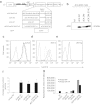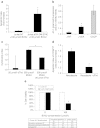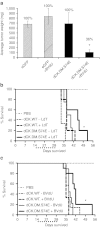Cell fate control gene therapy based on engineered variants of human deoxycytidine kinase
- PMID: 22273576
- PMCID: PMC3345984
- DOI: 10.1038/mt.2011.298
Cell fate control gene therapy based on engineered variants of human deoxycytidine kinase
Abstract
The safety of cell therapy applications can be enhanced by the introduction of Cell Fate Control (CFC) elements, which encode pharmacologically controlled cellular suicide switches. CFC Gene Therapy (CFCGT) offers the possibility of establishing control over gene-modified cells (GMCs) with regards to their proliferation, differentiation, or function. However, enzymes commonly employed in these approaches often possess poor kinetics and high immunogenicity. We describe a novel CFCGT system based on engineered variants of human deoxyCytidine Kinase (dCK) that overcomes limitations of current modalities. Mutants of dCK with rationally designed active sites that make them thymidine-activating were stably introduced into cells by recombinant lentiviral vectors (LVs). Transduced cells maintained growth kinetics and function. These dCK mutants efficiently activate bromovinyl-deoxyuridine (BVdU), L-deoxythymidine (LdT), and L-deoxyuridine (LdU), which are otherwise not toxic to wild-type cells. We show that mutant dCK-expressing Jurkat, Molt-4, and U87mg cells could be efficiently eliminated in vitro and in xenogeneic leukemia and tumor models in vivo. We also describe a fusion construct of the thymidine-activating dCK to the cytoplasmic tail-truncated LNGFR molecule and applications to in vivo eradication of primary human T cells. This novel CFCGT system offers unique plasticity with respect to the wide range of prodrugs it can potentiate, and can be used as a reliable safety switch in cell and gene therapy.
Figures





Similar articles
-
Engineered Thymidine-Active Deoxycytidine Kinase for Bystander Killing of Malignant Cells.Methods Mol Biol. 2019;1895:149-163. doi: 10.1007/978-1-4939-8922-5_12. Methods Mol Biol. 2019. PMID: 30539536
-
Engineered human tmpk/AZT as a novel enzyme/prodrug axis for suicide gene therapy.Mol Ther. 2007 May;15(5):962-70. doi: 10.1038/mt.sj.6300122. Epub 2007 Mar 20. Mol Ther. 2007. PMID: 17375075
-
Engineered human Tmpk fused with truncated cell-surface markers: versatile cell-fate control safety cassettes.Gene Ther. 2013 Jan;20(1):24-34. doi: 10.1038/gt.2011.210. Epub 2012 Jan 12. Gene Ther. 2013. PMID: 22241175
-
Structural and kinetic characterization of human deoxycytidine kinase variants able to phosphorylate 5-substituted deoxycytidine and thymidine analogues.Biochemistry. 2010 Aug 10;49(31):6784-90. doi: 10.1021/bi100839e. Biochemistry. 2010. PMID: 20614893 Free PMC article.
-
Adenoviral vector transduction of the human deoxycytidine kinase gene enhances the cytotoxic and radiosensitizing effect of gemcitabine on experimental gliomas.Cancer Gene Ther. 2008 Mar;15(3):154-64. doi: 10.1038/sj.cgt.7701115. Epub 2008 Jan 11. Cancer Gene Ther. 2008. PMID: 18188186
Cited by
-
Conditional lethality profiling reveals anticancer mechanisms of action and drug-nutrient interactions.Sci Adv. 2024 Oct 4;10(40):eadq3591. doi: 10.1126/sciadv.adq3591. Epub 2024 Oct 4. Sci Adv. 2024. PMID: 39365851 Free PMC article.
-
Metabolomics strategy reveals subpopulation of liposarcomas sensitive to gemcitabine treatment.Cancer Discov. 2012 Dec;2(12):1109-17. doi: 10.1158/2159-8290.CD-12-0197. Cancer Discov. 2012. PMID: 23230188 Free PMC article.
-
Development of Novel Immunotherapies for Multiple Myeloma.Int J Mol Sci. 2016 Sep 8;17(9):1506. doi: 10.3390/ijms17091506. Int J Mol Sci. 2016. PMID: 27618026 Free PMC article. Review.
-
New Variants of Tomato Thymidine Kinase 1 Selected for Increased Sensitivity of E. coli KY895 towards Azidothymidine.Cancers (Basel). 2015 Jun 8;7(2):966-80. doi: 10.3390/cancers7020819. Cancers (Basel). 2015. PMID: 26061968 Free PMC article.
-
A new pyrimidine-specific reporter gene: a mutated human deoxycytidine kinase suitable for PET during treatment with acycloguanosine-based cytotoxic drugs.J Nucl Med. 2010 Sep;51(9):1395-403. doi: 10.2967/jnumed.109.074344. J Nucl Med. 2010. PMID: 20810757 Free PMC article.
References
-
- Cooley LD, Sears DA, Udden MM, Harrison WR., and, Baker KR. Donor cell leukemia: report of a case occurring 11 years after allogeneic bone marrow transplantation and review of the literature. Am J Hematol. 2000;63:46–53. - PubMed
-
- Goring DR., and, DuBow MS. A cytotoxic effect associated with 9-(1,3-dihydroxy-2-propoxymethyl)-guanine is observed during the selection for drug resistant human cells containing a single herpesvirus thymidine kinase gene. Biochem Biophys Res Commun. 1985;133:195–201. - PubMed
Publication types
MeSH terms
Substances
Grants and funding
LinkOut - more resources
Full Text Sources
Other Literature Sources
Medical

